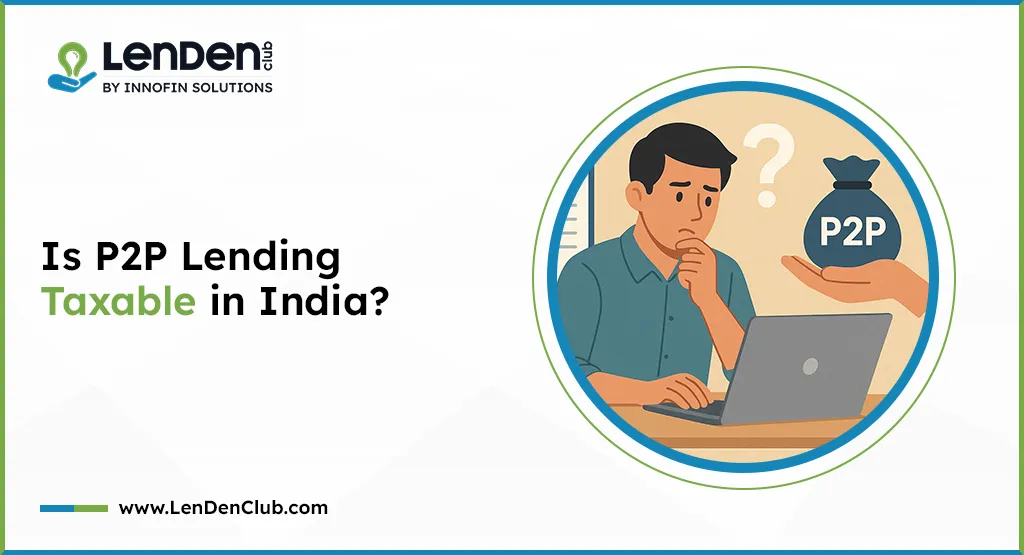Is P2P Lending Taxable in India?

Thinking of getting started with P2P lending, but worried about tax implications?
P2P lending has become one of India’s popular financial options. With earnings ranging from 10% to 15% annually, it attracts more and more monthly lenders.
But many don’t realise that every rupee you earn from P2P lending is taxable.
The good news? Understanding P2P taxation is not rocket science.
This guide breaks down everything you need to know about P2P lending taxes in India, from basic concepts to filing procedures.
What Makes P2P Lending Income Taxable?
Earnings from P2P lending fall under the category of interest income and are taxable under existing income tax rules. The amount you earn gets added to your total taxable income and is taxed as per your applicable income tax slab.
The Reserve Bank of India regulates P2P lending platforms. This regulatory framework ensures transparency and it means your earnings are tracked and reportable.
In short, if you earn interest from P2P lending, you owe taxes on it.
How P2P Lending Income Gets Taxed?
Your P2P lending earnings fall under “Income from Other Sources“. This is the same category used for:
- Fixed deposit interest
- Savings account interest
- Rental income from property
- Dividend income
The tax rate depends on your income slab. If you’re in the 30% tax bracket, you’ll pay 30% tax on your P2P interest income.
P2P Lending Tax Calculation Example
Let’s say you earned ₹50,000 from P2P lending in FY 2024-25:
- Your tax slab: 30%
- Tax on P2P income: ₹50,000 × 30% = ₹15,000
- Net income after tax: ₹35,000
This interest gets added to your salary or business income for total tax calculation.
TDS on P2P Lending – What You Need to Know
Most P2P platforms do not deduct TDS on interest payments. This means:
- You are responsible for calculating and paying taxes
- No advance tax deduction happens at source
- Full reporting burden lies with you
Some platforms might deduct TDS if your interest exceeds ₹10,000 annually.
When Platforms Do Deduct TDS
If a platform deducts TDS:
- You’ll get a TDS certificate
- Report the gross interest income in your ITR
- Claim credit for TDS paid
How to Report P2P Lending Income in Your ITR?
Filing P2P lending income correctly prevents tax department notices. Here’s your step-by-step process:
Step 1: Gather Your Documents
Collect these essentials:
- Annual interest statements from P2P platforms
- Bank statements showing interest credits
- Any TDS certificates (if applicable)
- Transaction history for defaults or losses
Step 2: Choose the Right ITR Form
Most P2P lenders file ITR-1 or ITR-2. ITR-1 works if you only have salary and P2P income. ITR-2 is needed for multiple income sources.
Step 3: Report Under “Income from Other Sources”
Enter your P2P interest income in the designated section. Don’t mix it with other income types – keep it separate and clearly marked.
Step 4: Include All Platform Earnings
Report income from all P2P platforms. Missing even small amounts can trigger penalties later.
Platform Fees and Tax Deductions
P2P platforms charge various fees:
- Platform usage fees
- Processing charges
- Recovery costs
- Exit fees
These fees may be deductible from your interest income. This reduces your taxable amount, lowering your tax liability.
Example of Fee Deduction
- Gross interest earned: ₹40,000
- Platform fees paid: ₹2,000
- Taxable income: ₹38,000
Always maintain receipts for all fees paid to P2P platforms.
If you go with LenDenClub, then this India’s largest P2P lending platform does not charge any opening and fund withdrawal fees.
Common Tax Filing Mistakes to Avoid
Below are some of the common mistakes most P2P lenders make during tax filing. Here’s how to avoid it:
- Underreporting Interest Income: Don’t ignore small amounts. Even ₹1,000 in interest income must be reported. Tax authorities cross-check platform data with your filing.
- Mixing Income Categories: Keep P2P income separate from salary or business income. Wrong classification can trigger audits and penalties.
- Missing TDS Claims: If platforms deducted TDS, claim the credit. Forgetting this means paying tax twice on the same income.
- Poor Record Keeping: Maintain comprehensive records. Store all platform statements, bank records, and correspondence about defaults.
Tax Planning Tips for P2P Lenders
If you are thinking to considering P2P lending opportunity to diversify your portfolio, then knowing below three tax planning tips will help you in managing interest income effectively:
- Timing Your Lending Activity: Consider spreading your lending across financial years. This can help manage your tax liability better.
- Portfolio Diversification: Don’t put all money in P2P lending. Mix with tax-saving options like ELSS or PPF to optimize your overall tax burden.
- Regular Monitoring: Track your P2P income throughout the year. This prevents surprises during tax filing season.
What Happens If You Don’t Report P2P Income?
The consequences are serious:
- Penalties up to 200% of tax due
- Interest charges on unpaid tax
- Prosecution in severe cases
- Permanent tax record affecting future compliance
Tax authorities increasingly scrutinise P2P transactions. With platforms required to report data, hiding income becomes nearly impossible.
Conclusion
P2P lending taxation isn’t complex once you understand the basics.
Your P2P interest income is fully taxable at your regular income tax rate.
The key to successful P2P lending is understanding both the earnings and tax obligations. Plan accordingly, maintain good records, and file your taxes correctly.